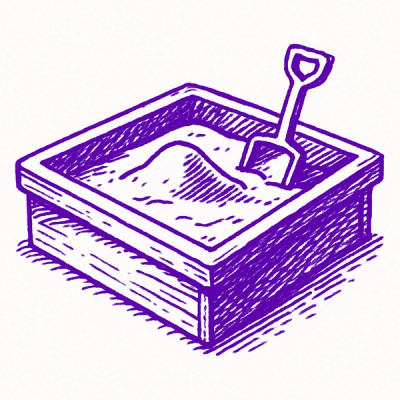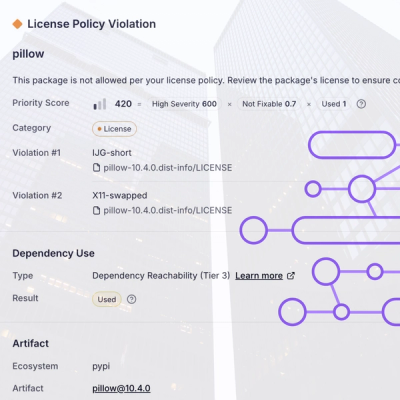
Research
/Security News
Critical Vulnerability in NestJS Devtools: Localhost RCE via Sandbox Escape
A flawed sandbox in @nestjs/devtools-integration lets attackers run code on your machine via CSRF, leading to full Remote Code Execution (RCE).

Frouros is a Python library for drift detection in machine learning systems that provides a combination of classical and more recent algorithms for both concept and data drift detection.
"Everything changes and nothing stands still"
"You could not step twice into the same river"
Heraclitus of Ephesus (535-475 BCE.)
As a quick example, we can use the breast cancer dataset to which concept drift it is induced and show the use of a concept drift detector like DDM (Drift Detection Method). We can see how concept drift affects the performance in terms of accuracy.
import numpy as np
from sklearn.datasets import load_breast_cancer
from sklearn.linear_model import LogisticRegression
from sklearn.model_selection import train_test_split
from sklearn.pipeline import Pipeline
from sklearn.preprocessing import StandardScaler
from frouros.detectors.concept_drift import DDM, DDMConfig
from frouros.metrics import PrequentialError
np.random.seed(seed=31)
# Load breast cancer dataset
X, y = load_breast_cancer(return_X_y=True)
# Split train (70%) and test (30%)
(
X_train,
X_test,
y_train,
y_test,
) = train_test_split(X, y, train_size=0.7, random_state=31)
# Define and fit model
pipeline = Pipeline(
[
("scaler", StandardScaler()),
("model", LogisticRegression()),
]
)
pipeline.fit(X=X_train, y=y_train)
# Detector configuration and instantiation
config = DDMConfig(
warning_level=2.0,
drift_level=3.0,
min_num_instances=25, # minimum number of instances before checking for concept drift
)
detector = DDM(config=config)
# Metric to compute accuracy
metric = PrequentialError(alpha=1.0) # alpha=1.0 is equivalent to normal accuracy
def stream_test(X_test, y_test, y, metric, detector):
"""Simulate data stream over X_test and y_test. y is the true label."""
drift_flag = False
for i, (X, y) in enumerate(zip(X_test, y_test)):
y_pred = pipeline.predict(X.reshape(1, -1))
error = 1 - (y_pred.item() == y.item())
metric_error = metric(error_value=error)
_ = detector.update(value=error)
status = detector.status
if status["drift"] and not drift_flag:
drift_flag = True
print(f"Concept drift detected at step {i}. Accuracy: {1 - metric_error:.4f}")
if not drift_flag:
print("No concept drift detected")
print(f"Final accuracy: {1 - metric_error:.4f}\n")
# Simulate data stream (assuming test label available after each prediction)
# No concept drift is expected to occur
stream_test(
X_test=X_test,
y_test=y_test,
y=y,
metric=metric,
detector=detector,
)
# >> No concept drift detected
# >> Final accuracy: 0.9766
# IMPORTANT: Induce/simulate concept drift in the last part (20%)
# of y_test by modifying some labels (50% approx). Therefore, changing P(y|X))
drift_size = int(y_test.shape[0] * 0.2)
y_test_drift = y_test[-drift_size:]
modify_idx = np.random.rand(*y_test_drift.shape) <= 0.5
y_test_drift[modify_idx] = (y_test_drift[modify_idx] + 1) % len(np.unique(y_test))
y_test[-drift_size:] = y_test_drift
# Reset detector and metric
detector.reset()
metric.reset()
# Simulate data stream (assuming test label available after each prediction)
# Concept drift is expected to occur because of the label modification
stream_test(
X_test=X_test,
y_test=y_test,
y=y,
metric=metric,
detector=detector,
)
# >> Concept drift detected at step 142. Accuracy: 0.9510
# >> Final accuracy: 0.8480
More concept drift examples can be found here.
As a quick example, we can use the iris dataset to which data drift is induced and show the use of a data drift detector like Kolmogorov-Smirnov test.
import numpy as np
from sklearn.datasets import load_iris
from sklearn.model_selection import train_test_split
from sklearn.tree import DecisionTreeClassifier
from frouros.detectors.data_drift import KSTest
np.random.seed(seed=31)
# Load iris dataset
X, y = load_iris(return_X_y=True)
# Split train (70%) and test (30%)
(
X_train,
X_test,
y_train,
y_test,
) = train_test_split(X, y, train_size=0.7, random_state=31)
# Set the feature index to which detector is applied
feature_idx = 0
# IMPORTANT: Induce/simulate data drift in the selected feature of y_test by
# applying some gaussian noise. Therefore, changing P(X))
X_test[:, feature_idx] += np.random.normal(
loc=0.0,
scale=3.0,
size=X_test.shape[0],
)
# Define and fit model
model = DecisionTreeClassifier(random_state=31)
model.fit(X=X_train, y=y_train)
# Set significance level for hypothesis testing
alpha = 0.001
# Define and fit detector
detector = KSTest()
_ = detector.fit(X=X_train[:, feature_idx])
# Apply detector to the selected feature of X_test
result, _ = detector.compare(X=X_test[:, feature_idx])
# Check if drift is taking place
if result.p_value <= alpha:
print(f"Data drift detected at feature {feature_idx}")
else:
print(f"No data drift detected at feature {feature_idx}")
# >> Data drift detected at feature 0
# Therefore, we can reject H0 (both samples come from the same distribution).
More data drift examples can be found here.
Frouros can be installed via pip:
pip install frouros
The currently implemented detectors are listed in the following table.
| Drift detector | Type | Family | Univariate (U) / Multivariate (M) | Numerical (N) / Categorical (C) | Method | Reference |
|---|---|---|---|---|---|---|
| Concept drift | Streaming | Change detection | U | N | BOCD | Adams and MacKay (2007) |
| U | N | CUSUM | Page (1954) | |||
| U | N | Geometric moving average | Roberts (1959) | |||
| U | N | Page Hinkley | Page (1954) | |||
| Statistical process control | U | N | DDM | Gama et al. (2004) | ||
| U | N | ECDD-WT | Ross et al. (2012) | |||
| U | N | EDDM | Baena-Garcıa et al. (2006) | |||
| U | N | HDDM-A | Frias-Blanco et al. (2014) | |||
| U | N | HDDM-W | Frias-Blanco et al. (2014) | |||
| U | N | RDDM | Barros et al. (2017) | |||
| Window based | U | N | ADWIN | Bifet and Gavalda (2007) | ||
| U | N | KSWIN | Raab et al. (2020) | |||
| U | N | STEPD | Nishida and Yamauchi (2007) | |||
| Data drift | Batch | Distance based | U | N | Bhattacharyya distance | Bhattacharyya (1946) |
| U | N | Earth Mover's distance | Rubner et al. (2000) | |||
| U | N | Energy distance | Székely et al. (2013) | |||
| U | N | Hellinger distance | Hellinger (1909) | |||
| U | N | Histogram intersection normalized complement | Swain and Ballard (1991) | |||
| U | N | Jensen-Shannon distance | Lin (1991) | |||
| U | N | Kullback-Leibler divergence | Kullback and Leibler (1951) | |||
| M | N | Maximum Mean Discrepancy | Gretton et al. (2012) | |||
| U | N | Population Stability Index | Wu and Olson (2010) | |||
| Statistical test | U | N | Anderson-Darling test | Scholz and Stephens (1987) | ||
| U | N | Baumgartner-Weiss-Schindler test | Baumgartner et al. (1998) | |||
| U | C | Chi-square test | Pearson (1900) | |||
| U | N | Cramér-von Mises test | Cramér (1902) | |||
| U | N | Kolmogorov-Smirnov test | Massey Jr (1951) | |||
| U | N | Kuiper's test | Kuiper (1960) | |||
| U | N | Mann-Whitney U test | Mann and Whitney (1947) | |||
| U | N | Welch's t-test | Welch (1947) | |||
| Streaming | Distance based | M | N | Maximum Mean Discrepancy | Gretton et al. (2012) | |
| Statistical test | U | N | Incremental Kolmogorov-Smirnov test | dos Reis et al. (2016) |
Unlike other libraries that in addition to provide drift detection algorithms, include other functionalities such as anomaly/outlier detection, adversarial detection, imbalance learning, among others, Frouros has and will ONLY have one purpose: drift detection.
We firmly believe that machine learning related libraries or frameworks should not follow Jack of all trades, master of none principle. Instead, they should be focused on a single task and do it well.
Frouros is actively being used by the following projects to implement drift detection in machine learning pipelines:
If you want your project listed here, do not hesitate to send us a pull request.
Check out the contribution section.
If you want to cite Frouros you can use the SoftwareX publication.
@article{CESPEDESSISNIEGA2024101733,
title = {Frouros: An open-source Python library for drift detection in machine learning systems},
journal = {SoftwareX},
volume = {26},
pages = {101733},
year = {2024},
issn = {2352-7110},
doi = {https://doi.org/10.1016/j.softx.2024.101733},
url = {https://www.sciencedirect.com/science/article/pii/S2352711024001043},
author = {Jaime {Céspedes Sisniega} and Álvaro {López García}},
keywords = {Machine learning, Drift detection, Concept drift, Data drift, Python},
abstract = {Frouros is an open-source Python library capable of detecting drift in machine learning systems. It provides a combination of classical and more recent algorithms for drift detection, covering both concept and data drift. We have designed it to be compatible with any machine learning framework and easily adaptable to real-world use cases. The library is developed following best development and continuous integration practices to ensure ease of maintenance and extensibility.}
}
Frouros is an open-source software licensed under the BSD-3-Clause license.
Frouros has received funding from the Agencia Estatal de Investigación, Unidad de Excelencia María de Maeztu, ref. MDM-2017-0765.
FAQs
An open-source Python library for drift detection in machine learning systems
We found that frouros demonstrated a healthy version release cadence and project activity because the last version was released less than a year ago. It has 2 open source maintainers collaborating on the project.
Did you know?

Socket for GitHub automatically highlights issues in each pull request and monitors the health of all your open source dependencies. Discover the contents of your packages and block harmful activity before you install or update your dependencies.

Research
/Security News
A flawed sandbox in @nestjs/devtools-integration lets attackers run code on your machine via CSRF, leading to full Remote Code Execution (RCE).

Product
Customize license detection with Socket’s new license overlays: gain control, reduce noise, and handle edge cases with precision.

Product
Socket now supports Rust and Cargo, offering package search for all users and experimental SBOM generation for enterprise projects.